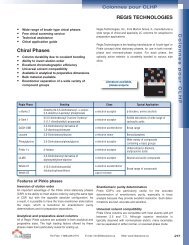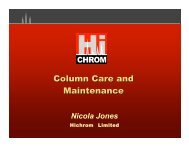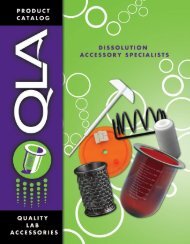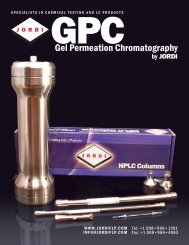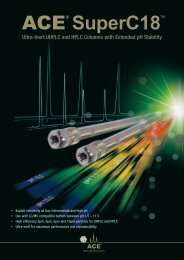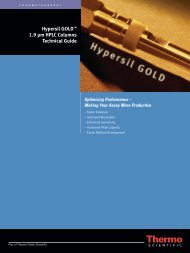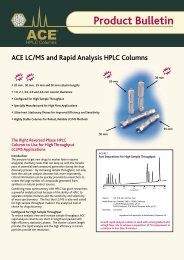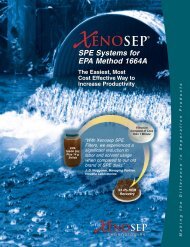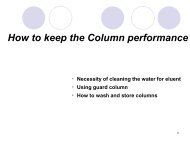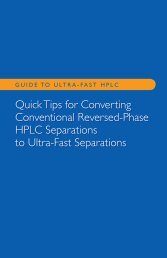HALO Penta-HILIC Brochure - Canadian Life Science
HALO Penta-HILIC Brochure - Canadian Life Science
HALO Penta-HILIC Brochure - Canadian Life Science
- No tags were found...
Create successful ePaper yourself
Turn your PDF publications into a flip-book with our unique Google optimized e-Paper software.
penta-<strong>HILIC</strong>UHPLC COLUMNS
penta-<strong>HILIC</strong>• Highly retentive, proprietary penta-hydroxy-ligand• Excellent peak shape for polar compounds with avariety of functional groups:• acids, bases, zwitterions• strong and weak acids, bases• peptides, sugars, nucleobases, nucleosides,nucleotides, and derivatives• Compatible with all typical <strong>HILIC</strong> operatingconditions• Fast equilibration of the column, especially usefulfor gradient separations• High stability under acidic and mildly basicconditions of operation• Very high efficiency packed columns (>200,000plates per meter)• Utilizes Halo Fused-Core® particles with 2.7 umparticle diameter and 0.5 um thick porous layer, formaximum performance at any flow rate• Available in a broad range of column dimensionsfor a variety of analytical applications• Moderate back pressure places less stress on instrumentparts and permits these UHPLC columns tobe used with conventional HPLC equipment.• The use of 2 μm porosity column inlet frits reducesthe inconvenience caused by pressure increasesfrom plugged fits and makes <strong>HALO</strong> columns moreforgiving and easier to use than columns packedwith sub-2 μm particles.
Mobile phase buffersFor optimum column efficiency and reproducibility, buffers in the range of 10 - 20mM concentration or additives in the 0.5% range can be used in the mobile phase.Phosphate buffers are not recommended because of their poor solubility in highorganic mobile phases and incompatibility with MS detection. Additives such asformic acid, trifluoroacetic acid and phosphoric acid at concentrations up to about1% can be used in the mobile phase. Volatile ammonium formate/formic acid buffersup to a final concentration of about 20 mM and pH 3 are especially effectivefor separating both basic and acidic compounds when interfacing the liquid chromatographto a mass spectrometer. Acetonitrile/formate mobile phases seem to bea good starting point for many separations of both basic and acidic compounds.Ammonium acetate at pH ~5 has also been used at concentrations of 5 - 20 mM,but is generally less effective for separating stronger basic and acidic compounds.Buffers or additives above pH 6 usually are not recommended because they mayenhance the slow dissolution of the silica support.Sample conditionsAs with reversed phase, the solvent used to inject the sample is an importantconsideration with <strong>Penta</strong>-<strong>HILIC</strong>. As in reversed-phase, the sample solvent should,as closely as possible, resemble the strength and type of the mobile phase. Thesample solvent can contain a higher amount of organic than the mobile phase,but if it contains a higher amount of polar solvent (e.g., water), peak shape will becompromised, especially with early-eluting compounds. A mixture of 75:25 (v/v)acetonitrile/methanol is sometimes useful as the sample solvent, if for some reasonit is not possible to inject the sample dissolved in the mobile phase.Very strong solvents such as dimethylformamide or dimethylsulfoxide will usuallyresult in poor peak shapes and are not recommended. These solvents will generallyhave to be diluted with a weaker solvent such as acetonitrile before satisfactorypeak shape can be obtained.Figure 2: Separation of Antiulcer DrugsTEST CONDITIONS:Column: 4.6 x 100 mm, <strong>HALO</strong> <strong>Penta</strong>-<strong>HILIC</strong>Part Number: 92814-605Mobile Phase: 10/90: A/BA= 0.04 M Ammonium formate, pH=3.0 (adj.)B= AcetonitrileFlow Rate: 3.0 mL/min.Pressure: 210 BarTemperature: 30° CDetection: UV 254 nm, VWDInjection Volume: 2 μLSample Solvent: mobile phaseResponse Time: 0.02 sec.Flow Cell: 2.5 μL semi-microLC System: Shimadzu Prominence UFLC XRECV:~14 μLPEAK IDENTITIES:1. Cimetidine2. Nizatidine3. Famotidine4. RanitidineCimetidineFamotidineNizatidineRanitidineThe strongly basic antiulcer drugs can be rapidlyseparated on <strong>HALO</strong> <strong>Penta</strong>-<strong>HILIC</strong> phase using amobile phase that works well with a mass spectrometerdetector.
Figure 3: Separation of Beta Blocker DrugsFigure 4: Separation of AntidepressantsTEST CONDITIONS:Column: 4.6 x 100 mm, <strong>HALO</strong> <strong>Penta</strong>-<strong>HILIC</strong>Part Number: 92814-605Mobile Phase: 10/90: A/BA= 0.04 M Ammonium formate buffer, pH=3.0B= AcetonitrileFlow Rate: 3.0 mL/min.Pressure: 215 BarTemperature: 30° CDetection: UV 254 nm, VWDInjection Volume: 2.0 μLSample Solvent: mobile phaseResponse Time: 0.02 sec.Flow Cell: 2.5 μL semi-microLC System: Shimadzu Prominence UFLC XRECV:~14 μLPEAK IDENTITIES:1. Alprenolol2. Propranolol3. Pindolol4. Acebutolol5. AtenololAlprenololTEST CONDITIONS:Column: 4.6 x 100 mm, <strong>HALO</strong> <strong>Penta</strong>-<strong>HILIC</strong>Part Number: 92814-605Mobile Phase: 7/93: A/BA= 0.1 M Ammonium formate, pH=3.5 (adj.)B= AcetonitrileFlow Rate: 2.5 mL/min.Pressure: 165 BarTemperature: 30°CDetection: UV 254 nm, VWDInjection Volume: 0.5 μLSample Solvent: 10/90: Water/AcetonitrileResponse Time: 0.02 sec.Flow Cell: 2.5 μL semi-microLC System: Shimadzu Prominence UFLC XRECV:~14 μLPEAK IDENTITIES:1. Trimipramine2. Amitriptyline3. Doxepin4. Nortriptyline5. AmoxapineTrimipramineAmitriptylinePropranololDoxepinPindololNortriptylineAcebutololThe <strong>HALO</strong> <strong>Penta</strong>-<strong>HILIC</strong> stationary phase can rapidlyseparate highly basic compounds with good peakshapes in a mass spectrometry friendly mobile phase.AtenololBasic drugs such as antidepressants can be separatedrapidly under <strong>HILIC</strong> conditions with good peakshape using <strong>HALO</strong> <strong>Penta</strong>-<strong>HILIC</strong> stationary phase.Amoxapine
<strong>Penta</strong>-<strong>HILIC</strong> Specifications <strong>Penta</strong>-<strong>HILIC</strong> Ordering• Hydroxylated-ligand (five hydroxyl groups)• Ultra-pure, “Type B” silica• 1.7 μm solid core particle with a 0.5 μm porous silica layer fused to the surface• 150 m 2/gram surface area• 90 Å pore size• pH range: 2 to 9• Maximum Temperature: 60°C• Maximum Pressure: 9,000 psi, 600 bar<strong>HILIC</strong> references1. A. J. Alpert, J. Chromatogr., 499 (1990) 177-196.2. P. Hemström, K. Irgun, J. Sep. <strong>Science</strong>, 29 (2006) 1784-1821.3. B. A. Bidlingmeyer, J. K. Del Rios, J. Korpi, Anal. Chem., 54 (1982) 442-447.4. E. S. Grumbach, D. M. Wagrowski-Diehl, J. R. Mazzeo, B. Alden, P. C.Iraneta, LCGC, 22 (2004) 1010-1023.5. J. Pesek, M. T. Matyska, LC-GC, 25 (2007) 480-490.6. D. V. McCalley, J. Chromatogr. A, 1171 (2007) 46-55.<strong>HALO</strong> <strong>Penta</strong>-<strong>HILIC</strong> ColumnsColumn DimensionsPart Number2.1x20mm 928122052.1x30mm 928123052.1x50mm 928124052.1x75mm 928125052.1x100mm 928126052.1x150mm 928127053.0x20mm 928132053.0x30mm 928133053.0x50mm 928134053.0x75mm 928135053.0x100mm 928136053.0x150mm 928137054.6x20mm 928142054.6x30mm 928143054.6x50mm 928144054.6x75mm 928145054.6x100mm 928146054.6x150mm 92814705<strong>HALO</strong> <strong>Penta</strong>-<strong>HILIC</strong> Guard Columns (3/pk)Column DimensionsPart Number2.1mm ID 928121053.0mm ID 928131054.6mm ID 92814105Guard Holder 94900001



